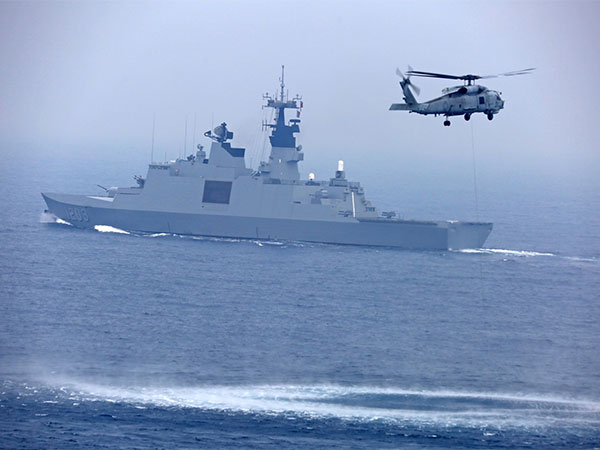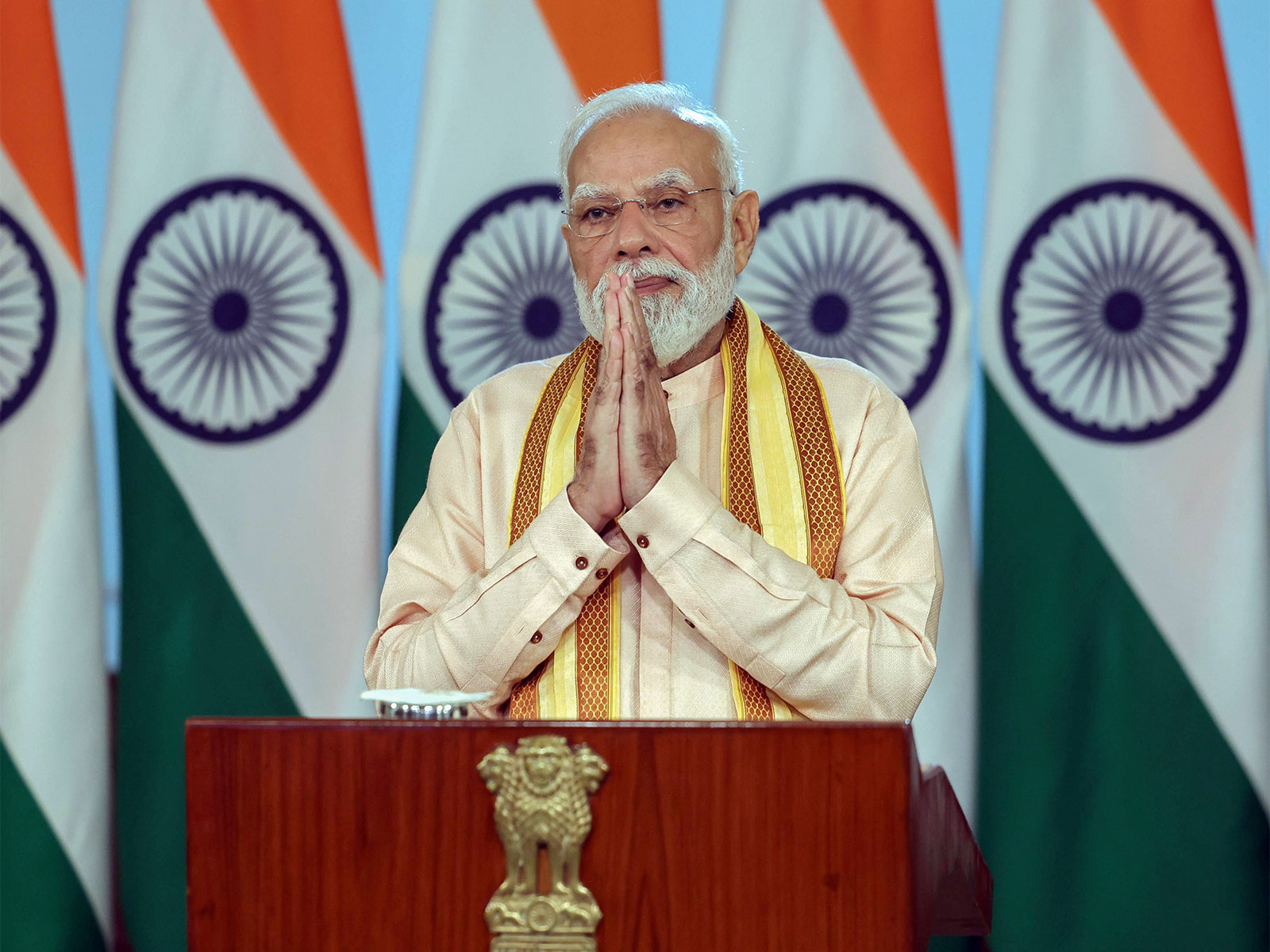By Ishaan Prakash
Hong Kong, April 29 (ANI): The oil tanker exploded with a ferocious roar, sprouting roiling flames and smoke, before quickly succumbing to the waves near the Taiwanese port city of Kaohsiung. Elsewhere, a few hours later, a Taiwanese frigate hit another sea mine laid near the dual commercial and naval port of Keelung. These events were among the opening gambit of a Chinese invasion of Taiwan.
In fact, belts of sea mines had been surreptitiously laid all around Taiwan, particularly near ports. Sometimes the deed was done by rusty Chinese, but foreign-flagged, fishing trawlers where crews surreptitiously rolled mines into the sea. Others had been stealthily placed by Chinese submarines belonging to the People’s Liberation Army (PLA).
Even earlier, the PLA had been releasing underwater gliders from the mainland coastline, individually and in swarms, to travel miles towards their intended targets. These gliders were essentially self-propelled sea mines that clustered around Taiwanese ports, some sitting patiently on the seabed before receiving a coded signal to deploy. Indeed, this fleet of kamikaze gliders represents a complete game-changer, for Taiwanese seabed listening networks cannot detect them, plus such technology offers China plausible deniability. If they are discovered, Beijing simply denies any knowledge of them.
The above is obviously a fictitious scenario, and it is hopefully one that never comes to pass. However, the reality is that sea mines and underwater warfare would play a critical role in any Chinese attempt to capture Taiwan.
The PLA has an estimated stockpile of 50,000-100,000 sea mines of more than 30 varieties, although this total could easily be undercounted since mines are so easy to hide. If China attempted either a naval blockade of Taiwan or a full-blown invasion, then seeding minefields outside ports and naval bases in Taiwan – and in places like Australia and Japan that might be tempted to intervene – may loom large in PLA war planning. China would undoubtedly lay mines outside US Navy facilities in the region, such as those in Guam and Japan, and block main channels before a blockade is enforced. A report about Chinese mine warfare capabilities, published by the US Naval War College, assessed, “Estimates of the number of mines currently required to blockade Taiwan vary between seven and 14 thousand, which amounts to a relatively small proportion of available estimates of PLA Navy (PLAN) aggregate sea mine stocks.”
According to the writings of Chinese military strategists, key objectives for a PLA offensive mine strategy are “blockading enemy bases, harbors and sea lanes; destroying enemy sea transport capabilities; attacking or restricting warship mobility; and crippling and exhausting enemy combat strength”. Additionally, in littoral warfare, “Sea mines constitute the main threat to every navy, and especially for carrier battle groups and submarines.” China’s 2008 defence white paper mentioned minelaying no fewer than three times.
Submarines are obviously highly important to China, thanks to their stealth and how difficult they are to track. The PLAN possesses 48 conventional and twelve nuclear-powered submarines, according to the Pentagon’s most recent annual report on China’s military.
However, as the aforementioned US Naval Warfare College report notes, “Submarines are large and difficult to hide, and various intelligence agencies of other powers are no doubt attuned to the scope and dimensions of these important developments. By contrast, mine warfare capabilities are easily hidden and thus constitute a true ‘assassin’s mace’
for the PLAN.” An ‘assassin’s mace” is best explained by the English metaphor of a “silver bullet”.
Combining the best of both worlds, Chinese naval strategists logically place a high value on submarine delivery of mines. It is thought that modern Yuan-class diesel-electric submarines can carry up to 30 mines.
The American report about Chinese mine warfare continued: “Having systematically analysed the advantages and disadvantages of various minelaying platforms, Chinese analysts appear to have concluded that submarine delivery of mines is optimal for
offensive mining missions, especially at long range. The advantages of using submarines to lay mines include their stealth, their ability to lay mines precisely, and their ability to penetrate difficult targets (perhaps by using mobile mines).”
The authors added: “It is additionally noted that the high accuracy and effectiveness of submarine delivery enables the planting of fewer mines to achieve the same effect. According to one analysis, ‘The restrictions imposed on submarines by air and naval forces are relatively small, [so] penetrating the enemy’s rear area to lay mines is much easier.’ Also, according to another report, this platform ‘has the highest qualities of stealth and potential for surprise … [because] a vessel set at a distance of 10-15km outside of a harbour, in a sea area with a depth of about 40m, will be capable of launching an effective mobile mine to penetrate a sea port.'”
Whilst Chinese submarines can clandestinely lay mines, aircraft can alternatively drop them quickly and in quantity. For instance, H-6 bombers can each carry 12-18 500kg sea mines. The PLA is already violating Taiwan’s air defence identification zone on a daily basis, so it could easily proceed to dropping mines with no warning.
“Complementing the robust capabilities described above are the thousands of Chinese fishing and merchant vessels that could be pressed into service.” Indeed, the report warned, “A disturbing component of PLAN minelaying is the prospect of civilian cooperation to supplement military assets.” China has something like 30,000 iron-hulled fishing trawlers, each of which can carry ten mines.
Fishing vessels displacing 100-200 tons are ideal for mine warfare because there are thousands of them, they offer small targets, and their profiles are not as suspicious as a naval hull. Furthermore, only minor modifications are necessary to install simple mine-laying equipment on them. Already, the People’s Armed Forces Maritime Militia controls hundreds of such “civilian” vessels, all ready for use by the PLAN.
The beauty of mines is that they are an ideal way to choke commercial traffic, bringing sea traffic to a grinding halt. Ship owners and insurance companies would not allow cargo vessels to sail to or from Taiwan because of the inherent danger from mines, and China could achieve a logistical stranglehold over Taiwan. Moreover, many countries are almost totally reliant upon seaborne trade. Seaborne shipping accounts for 99% of Australia’s international trade, for instance, so any regional disruption to shipping would be catastrophic.
It is suggested that 810,000 sea mines were laid during World War II, sinking approximately 2,700 ships. However, just the threat of mines would achieve the same result as actually laying them. It would require naval assets to physically search for and neutralise any mines that were found. This is a time-consuming and labour-intensive task. As the Chinese say, mines are easy to lay, hard to sweep.
Of course, sea mines are just one component of Chinese underwater warfare. While they could appear as a prelude to war or be replenished during a conflict, China has other methods available in scenarios short of armed conflict. As part of its grey-zone harassment tactics, China is already accused of tampering with seabed communication cables around Taiwan and its offshore islands.
For instance, in April, the Taiwan authorities legally charged the Chinese captain of the highly suspicious cargo vessel Hong Tai 58 for damaging an underwater communications cable that connects Taiwan to the Penghu Islands near the Chinese coast. Taiwan’s Coast Guard Administration detained this Togolese-flagged cargo vessel crewed by Chinese sailors on 25 February 2025.
Nor was this an isolated incident. A similar case occurred north of Taiwan in January 2025, where a Hong Kong-owned commercial vessel was implicated as the culprit. Alarmingly, Taiwan has reported five cases of seabed cable damage this year already, a
figure that compares with just three incidents in 2023 and the same number in 2024. Taiwan’s coast guard now has a blacklist of nearly 100 suspicious China-linked ships upon which it keeps a careful eye.
Beijing denies any knowledge of these seabed attacks, where “innocent” cargo vessels accidentally drag their anchors and weave back and forth over locations where internet cables run along the seafloor. Russia is also accused of routinely doing the same in
locales like the Baltic Sea, confirming that it is a favoured method of nefarious rogue states.
The USA, for one, is certain about who is responsible for Taiwan’s outages. During a House Armed Services Committee testimony in Washington, DC on 10 April, Senator Jacky Rosen remarked that China’s “reckless, coercive and aggressive activities pose a
threat to democracies around the globe, and its sabotage of those undersea cables has emerged as a particularly alarming tactic”.
Admiral Samuel Paparo, Commander of the US Indo-Pacific Command, acknowledged in that same hearing that there were indeed Chinese attempts to sabotage undersea internet cables, particularly around Taiwan.
It was somewhat ironic, then, that just a few weeks after Taiwanese authorities seized Hong Tai 58 in February, Hong Kong-based media revealed that the state-owned China Ship Scientific Research Centre had patented a deep-sea device “capable of severing the
world’s most fortified underwater communication or power lines”. Although Beijing denies that it cuts others’ communication cables, its own state-affiliated scientists have been developing deep-sea vessels designed to do exactly that!
In his recent hearing, Paparo proposed two countermeasures against Chinese sabotage of underwater cables. The first is deterrence, “the ability to penetrate from an intelligence standpoint and to be there in the locations where they would be otherwise cutting those
cables”. This means Taiwan, or any other nation targeted by such sabotage, must know what is going on in their waters and who the potential hostile players are.
The second measure, Paparo said, is resilience. If a cable is cut, Taiwan needs to have redundancies in terms of communication networks to ensure that information continues to flow freely. This includes multiple backup cables and far more satellite constellations in low Earth orbit to keep the internet running.
Seabed warfare and protecting underwater cables from sabotage is a growing priority for many countries, but the best method of defence is a combination of robust deterrence, persistent surveillance and rapid response.
Dr. Ross Babbage, CEO of Strategic Forum in Australia, told ANI that the threat requires a layered, whole-of-nation approach. “In conjunction with automatic identification systems on ships, you can make sure people are following the correct channels and their
prescribed route, because they’re only going to do these things if they deviate from their normal route. So there are bell ringers there to target, then an asset to go and have a look.” Babbage stated that nations need to conduct careful surveillance of their near seas. “If you can do that, then you can pinpoint those anomalies and start to put the heat on them before they do it, or certainly capture them after they’ve done it, as they’ve done in Europe, and deal with it on a diplomatic basis.”
Another advantage of the “assassin’s mace” of sea mines is that American mine countermeasure capacities are rather weak. The USA and its allies would be extremely hard-pressed to detect and clear extensive minefields. This all means that sea mines could
be a Chinese weapon of choice in any future conflict with the USA. Likewise, Taiwan owns just seven minesweeping or mine-hunting vessels, all of which are old. Then again, there are two sides to the sword. Taipei also regards mine warfare as an asymmetric warfare tool that it can use against the PLA. Taiwan’s navy already possesses four fast mine-laying boats, and the country awarded a contract to Lungteh Shipbuilding for six additional mine-laying vessels on 16 April 2025.
These new 41 m-long, steel-hulled boats are slated to be completed by the end of 2026. Each mine-layer in the 192nd Fleet based in Kaohsiung can carry up to 64 Wan Hsiang sea mines. To thwart a PLA amphibious invasion of Taiwan, its navy could lay
minefields ahead of Chinese naval task groups. (ANI)
Disclaimer: This story is auto-generated from a syndicated feed of ANI; only the image & headline may have been reworked by News Services Division of World News Network Inc Ltd and Palghar News and Pune News and World News
HINDI, MARATHI, GUJARATI, TAMIL, TELUGU, BENGALI, KANNADA, ORIYA, PUNJABI, URDU, MALAYALAM
For more details and packages
















